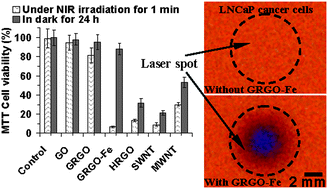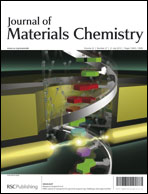The use of a glucose-reduced graphene oxide suspension for photothermal cancer therapy†
Abstract
A single-step green method for effective reduction and functionalization of graphene oxide (GO) by glucose was developed. Then, efficacy of the glucose-reduced GO sheets in photothermal therapy of LNCaP prostate cancer cells was investigated in vitro. The GO suspension reduced and functionalized by glucose in the presence of Fe catalyst showed a biocompatible property with an excellent near-infrared (NIR) photothermal therapy efficiency better than hydrazine-reduced GO, single-wall and multi-wall carbon nanotube suspensions which even showed some levels of toxicities. For complete destruction of the cancer cells at some time intervals of NIR irradiation (e.g., 0.5 and 12 min with a power density of 7.5 W cm−2), minimum concentrations of the reduced GO sheets (i.e., 1 and 0.05 mg mL−1) were obtained. The high photothermal therapy efficiency and biocompatibility of the glucose-reduced GO sheets were assigned to functionalization of the reduced sheets by gluconate ions which also prevented their aggregation. Our results suggest that the glucose-reduced GO sheets can be used as biocompatible and efficient photothermal agents in upcoming nanotechnology-based cancer therapies without any common functionalization by polyethylene glycol.


 Please wait while we load your content...
Please wait while we load your content...